U.S. Department of Transportation
Federal Highway Administration
1200 New Jersey Avenue, SE
Washington, DC 20590
202-366-4000
Federal Highway Administration Research and Technology
Coordinating, Developing, and Delivering Highway Transportation Innovations
|
R&T NOW This newsletter is an archived publication and may contain dated technical, contact, and link information. |
|
| Publication Number: Date: November/December 2019 |
Publication Date: November/December 2019
|
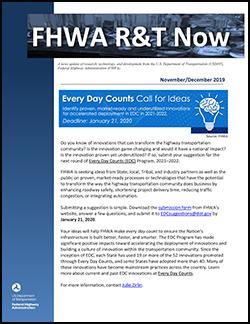
PDF files can be viewed with the Acrobat® Reader®
In this issue…

Do you know of innovations that can transform the highway transportation community? Is the innovation game changing and would it have a national impact? Is the innovation proven yet underutilized? If so, submit your suggestion for the next round of Every Day Counts (EDC) Program, 2021–2022.
FHWA is seeking ideas from State, local, Tribal, and industry partners as well as the public on proven, market-ready processes or technologies that have the potential to transform the way the highway transportation community does business by enhancing roadway safety, shortening project delivery time, reducing traffic congestion, or integrating automation.
Submitting a suggestion is simple. Download the submission form from FHWA's website, answer a few questions, and submit it to EDCsuggestions@dot.gov by January 21, 2020.
Your ideas will help FHWA make every day count to ensure the Nation's infrastructure is built better, faster, and smarter. The EDC Program has made significant positive impacts toward accelerating the deployment of innovations and building a culture of innovation within the transportation community. Since the inception of EDC, each State has used 19 or more of the 52 innovations promoted through Every Day Counts, and some States have adopted more than 40. Many of these innovations have become mainstream practices across the country. Learn more about current and past EDC innovations at Every Day Counts.
For more information, contact Julie Zirlin.
The FHWA Exploratory Advanced Research (EAR) Program uses the National Academy of Sciences' (formerly the National Research Council's) Research Associateship Program (RAP) to complement the expertise of permanent research staff on a short-term basis. Associates work with FHWA advisers to conduct important research across a wide range of topics and disciplines.
Since 1992, FHWA has sponsored 50 research associates. Two of those associates—Mehdi Zamanipour and Rafic El-Helou—started conducting research at Turner-Fairbank Highway Research Center (TFHRC) in 2016. Their work has contributed to advancing research in two important areas: connected and automated vehicles (CAV) and ultra high-performance concrete (UHPC).
Zamanipour received his Ph.D. from the University of Arizona in industrial engineering, where his research focused on connected vehicle (CV) technology, traffic optimization, and data modeling. He was selected for RAP and began working with his adviser, Govind Vadakpat, in FHWA's Office of Operations Research and Development (R&D) on a project titled "Cost-Benefit Analysis of Connected and Automated Vehicle Operations."
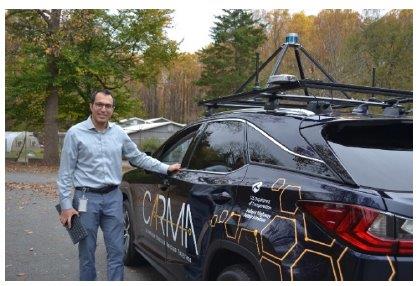
Source: FHWA
Research associate Mehdi Zamanipour works with one of the CARMA vehicles at TRFHC.
He currently is working as part of the CARMA team to leverage automated driving technologies to increase safety and reliability. Zamanipour is developing optimization models for deploying cooperative automated driving technologies along signalized corridors to support the CARMA platform.
The real-world experiences that he has obtained at FHWA have given him valuable exposure to the development of CAV. In January 2020, Zamanipour will become a software engineer at an autonomous vehicle (AV) technology company.
El-Helou received his doctorate in structural engineering from Virginia Tech. During his time as an associate, he worked under the guidance of Benjamin Graybeal in the FHWA Office of Infrastructure R&D on UHPC-related projects. The goals of these projects were to develop a UHPC bridge-design specification draft for the American Association of State Highway and Transportation Officials (AASHTO) and advance innovative structural applications that fully utilize UHPC's durability and performance characteristics.
The research could encourage simplicity, speed, and creativity in designing and implementing UHPC in the highway system. El-Helou's investigation also provided suggestions on the optimal use of UHPC in innovative highway applications, including extending the span range of concrete bridges beyond the current limit of approximately 200 ft. In addition, El-Helou conducted material-level tests as part of an effort to standardize mechanical testing of UHPC. His work as an associate allowed him to examine different parts of structural design, including material behavior, testing methods, mechanical models, and flexural and shear behaviors of UHPC components.
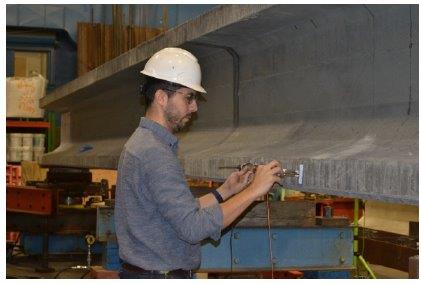
Source: FHWA
Former research associate Rafic El-Helou installs sensors to measure the deformation of an ultra high-performance concrete beam in FHWA's structures laboratory.
El-Helou concluded his tenure as an associate in October 2019, but he remains at TFHRC as a contractor in the structures lab. "My passion to continue working on UHPC structural guidance prompted me to stay at TFHRC and continue the work I started as an associate," he said.
For more information about the RAP at TFHRC, visit the NRC Associates page on the EAR Program website or contact Jim Shurbutt at 202–493–3420 or Jim.Shurbutt@dot.gov.
The Federal Highway Administration's (FHWA) CARMA program participated in the FedTech Startup Studio for the Fall 2019 cohort [group].
FedTech is a startup initiative that seeks to build teams of entrepreneurs around breakthrough technologies developed by Government laboratories and other research facilities. FedTech's goal is to support the technology transfer of Government research products to market. FedTech assembles a team of entrepreneurs around each technology accepted into the program in an 8-week cohort in which each team develops business models around the technology with the help of mentors and instructors to build profitable companies.
The CARMA program built the CARMA open-source software, which facilitates vehicle-to-vehicle (V2V) and vehicle-to-infrastructure (V2I) communication to support cooperative automation. Cooperative automation will increase the capacity of the Nation's roads by, for example, allowing vehicles to travel closer together more safely. Cooperative automation will increase safety because the vehicle will be informed of potential hazards ahead of time, which will help reduce unsafe conditions.
CARMA has two main products: the CARMA PlatformSM, which physically sits in a vehicle to enable the vehicle to perform cooperative automation strategies, and the CARMA CloudSM, which provides rules and information to vehicles to help them move through traffic as safely and efficiently as possible.
The fall 2019 cohort began with a kickoff weekend starting September 28, 2019. The cohort started with entrepreneurs planning business models around the various Government technologies (one of which was CARMA) and finished with final "practice pitches" on November 21st. The cohort was hosted in both Northern Virginia and Washington, DC, but entrepreneurs from around the country participated virtually via webinars.
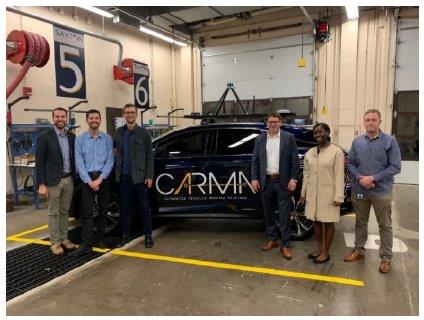
Source: FHWA
The CARMA team stands on the left (from left to right, Taylor Lochrane, Pavle Bujanović) and one of the CARMA mentors, Duncan Woodbury, is pictured. Members of FedTech stand on the right of the photo (from left to right, Steve Gilleland, Elizabeth Adadi, and Joe Lacy). The teams stand in front of a CARMA vehicle in the Saxton Transportation Operations Laboratory at TFHRC.
Taylor Lochrane, the CARMA technical program manager, and Pavle Bujanović, a CARMA project manager, both from FHWA's TFHRC, served as inventors for developing the CARMA technology business model.
Use Case for Increased Scooter Safety
During the 8-week cohort, the entrepreneurs performed considerable market research to develop a profitable concept around the CARMA technology to satisfy a Government and/or public pain point. The team decided on a use case that focused on the electric scooter-sharing system. Scooter safety is a major challenge for State departments of transportation (DOTs) and municipalities; some cities have denied electric scooter companies the right to work within their limits. This is partly because electric-scooter users do not always obey the rules of the road when using scooters (e.g., running red lights or stop signs), which can cause injuries to users, pedestrians, and vehicle drivers.
CARMA can be used to increase scooter safety and ensure that scooter users obey traffic laws. CARMA can help mitigate safety risks by sending rules, or electronic signals, to the electric scooter when a user might break a traffic law. For example, the signal might tell the scooter to reduce its speed as it approaches a red light.
Although the Startup Studio finished on November 21st, the entrepreneurs have decided to keep working on this use case. The entrepreneurs are currently reaching out to cities around the Nation to learn the features needed in CARMA to address all concerns related to electric-scooter safety. Entrepreneurs are also researching funding opportunities to make the necessary adjustments needed to host the CARMA Platform on electric scooters in addition to passenger cars and trucks, which is how CARMA is currently used. Activities like the Startup Studio are one of many ways FHWA is improving the transfer of its technologies from the laboratory to the market and supporting the Cross-Agency Priority Goals within the [U.S.] "President's Management Agenda."
For more information, contact Pavle Bujanović, 202–493–3271, pavle.bujanovic@dot.gov.
The USDOT SBIR program is a highly competitive, awards-based program that encourages domestic small businesses to engage in research and development that addresses high-priority research areas within the USDOT. The mission of the SBIR program is to support scientific excellence and technological innovation through the investment of Federal research funds in critical American priorities to build a strong national economy.
FHWA is participating in a new proposal solicitation and selection process to incentivize small businesses to provide highly innovative proposals and to aid in the review and selection of project teams that will provide the most promising solutions. The Volpe National Transportation Systems Center leads and manages the USDOT SBIR program. The new process is modeled after a successful program used by the United States Air Force. The unique elements of this new approach include:
FHWA plans to include three topics in the fiscal year 2020 USDOT Phase I solicitation for proposals. More information on the topics and specific dates will be announced early January 2020. For more information, visit the SBIR website or contact Craig Thor.
Applications are being accepted for LTPP Program Data Analysis Student Contest.
The theme for the 2019–2020 LTPP Data Analysis Student Contest is "Use the LTPP Data to Evaluate a Question or Concern for a Region or State," and the challenge topic is "Assess the Effect of Overweight Vehicles on Pavement Performance Using LTPP Traffic Data."
Submissions are due by July 1, 2020, and winners will be recognized at the 100th Transportation Research Board Annual Meeting in Washington, DC, January 2021.
Guidelines for the content can be found on the LTPP Data Analysis Student Contest page.
The contest is a joint effort of the LTPP Program and the Task Committee on the LTPP Contest, a subcommittee of the Highway Pavement Committee of the Transportation and Development Institute of the American Society of Civil Engineers.
The LTPP Program has sponsored this annual data analysis contest since 1998 to encourage university students, professors, and highway agency engineers to get involved in using the LTPP database. The database has been developed over the past three decades to contribute to a better understanding of pavement performance. The contest offers a unique opportunity for contestants to work individually or in a team to perform research that will benefit the highway transportation community. Benefits from previous contests have provided insight into pavement management, design, and preservation practices.
For more information, contact Deborah Walker at 202–493–3068 or deborah.walker@dot.gov.
The IHSDM 2019 Release (version 15.0.0) is available to download at www.ihsdm.org. IHSDM supports FHWA's Data-Driven Safety Analysis initiative through a suite of tools designed to evaluate the safety and operational effects of project-level geometric design decisions on highways.
The Crash Prediction Module (CPM), for example, is a powerful tool that implements the AASHTO Highway Safety Manual (HSM) "Part C – Predictive Method" for evaluation of rural two-lane highways, rural multilane highways, urban/suburban arterials, and freeways/interchanges. Typical applications of the CPM include evaluating the safety impacts of highway improvements, comparing the relative safety performance of design alternatives, and assessing the safety cost effectiveness of design decisions.
Released on October 31, 2019, IHSDM 2019 includes major enhancements on:
In a recent and ongoing application by MoDOT, the IHSDM CPM was used to analyze existing conditions (the "No Build" alternative) of the complex I–35/I–70 and US 169 interchange in Kansas City, MO. Included in the analysis were freeway segments and ramps, as well as portions of the local urban street network. Analysis of multiple "Build" alternatives using IHSDM is underway to assess the impact of proposed design improvements. Results will be used by MoDOT as input for selecting a preferred alternative design.
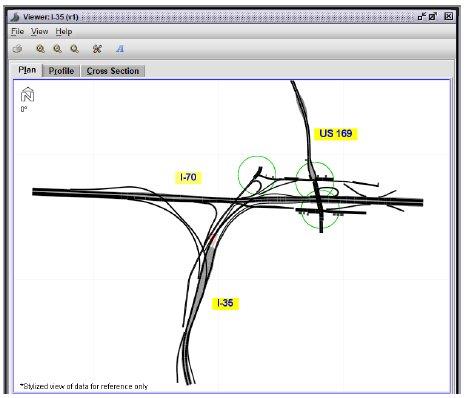
Source: FHWA
A representation of the I–35/I–70 and US 169 interchange in the IHSDM Highway Viewer.
The IHSDM 2019 Release includes six evaluation modules: Crash Prediction, Policy Review, Design Consistency, Traffic Analysis, Driver/Vehicle, and Intersection Review.
In addition, the IHSDM Economic Analyses Tool allows users to perform economic analyses within IHSDM, using CPM evaluation results (crash frequencies and severities).
For more information, contact Clayton Chen, 202–493–3054.
The "SHRP 2 Naturalistic Driving Study Pooled Fund: Advancing Implementable Solutions," managed under the FHWA Transportation Pooled Fund program, is sponsoring new research using data from the Naturalistic Driving Study (NDS) for the second Strategic Highway Research Program (SHRP2). The research will address priority topics in highway safety, operations, and planning.
FHWA leads the pooled fund study with active participation from State DOTs to determine the research to be explored. State DOTs include Alabama, Connecticut, Illinois, Iowa, Nevada, and Washington. Within FHWA, the Office of Operations; the Office of Planning, Environment, and Realty; and the Office of Safety R&D are participating.
The Technical Advisory Committee (TAC) for the pooled fund issued a request for proposals during the first quarter of 2019, spanning highway safety, operations, and planning research. Twenty-five projects were proposed totaling approximately $8 million. The TAC had a $2.1 million budget and chose six projects. Project deliverables will provide the highway practitioner with actionable results through guidelines, recommendations, and/or practitioner-friendly tools.
The six chosen projects include:
Webinars will be provided to the research community at the start of these projects during the first quarter of 2020, after project completion in 2022, and for other technology transfer activities.
For more information on these projects or the "SHRP2 Naturalistic Driving Study Pooled Fund: Advancing Implementable Solutions," contact Charles Fay at FHWA's TFHRC.
The Virtual Public Involvement (VPI) initiative, launched in 2018 by the FHWA Every Day Counts-5 Program, seeks to engage the public more effectively by supplementing face-to-face information sharing and gathering with the introduction of new technologies. Using VPI tools, which can include mobile applications, videos, virtual town halls, and mapping programs, enhances and broadens the reach of two-way communication efforts by making participation more convenient, affordable, and enjoyable. Engaging more people earlier in the transportation decision-making process can help State DOTs, Metropolitan Planning Organizations, and local public agencies reduce project delays, enhance transparency, and lower staff time and costs-per-person engaged. The tools and strategies promoted by VPI are applicable to both the development of transportation planning products and project development, particularly during environmental review.
The initiative groups VPI tools and strategies into eight categories. The FHWA VPI team and the Volpe Center have developed a VPI website that houses key information and resources, including fact sheets, best practice case study videos, and recordings of VPI-related webinars. The VPI team offers technical assistance opportunities, which includes peer-exchange workshops, conference presentations, and direct peer-to-peer assistance.
For more information on the initiative, please visit the website, or contact Scott Allen, Office of Planning - Stewardship and Oversight Team.
Innovator November/December 2019
In this issue: Accelerated Bridge Construction Changes, How Transportation Agencies Do Business; New Jersey, Pennsylvania, and Washington Win STIC Excellence Awards; States Innovate!; Agents for Change; Innovations Help States Deliver Outstanding Transportation Projects; Visualize Rural Roadway Departure Countermeasures with Trading Cards.
The issue is available online.
Public Roads Autumn 2019
This issue includes: Alternative Cementitious Materials: An Evolution or Revolution; Meet the SHRP2 Utilities Bundle; Are You an Innovation Champion?; Learning from International Perspectives; Speeding Up Bridge Deck Evaluations.
For more information, contact Maria Romstedt, Maria.Romstedt@dot.gov.
Turner-Fairbank Highway Research Center:
https://highways.dot.gov/research/
Resource Center:
www.fhwa.dot.gov/resourcecenter/
National Highway Institute:
www.nhi.fhwa.dot.gov/home.aspx
FHWA R&T Now is a newsletter containing information and updates about research, technology, and development from the U.S. Department of Transportation, Federal Highway Administration. The newsletter is an electronic newsletter and is updated approximately every other month. Send your comments, questions, and feedback to FHWA_Now@dot.gov.
Online access:
https://www.fhwa.dot.gov/publications/rtnow/.
Please forward this newsletter to others you think might find it interesting and/or useful.
Suggestions may be submitted to FHWA_Now@dot.gov.
Mail:
Federal Highway Administration
FHWA Office of Research, Development, and Technology
Attention: R&T Now Managing Editor
6300 Georgetown Pike
McLean, VA 22101
| AASHTO | American Association of State Highway and Transportation Officials |
|---|---|
| AV | Automated Vehicle |
| CPM | Crash Prediction Module |
| CV | Connected Vehicle |
| CAV | Connected and Automated Vehicle |
| CMF | Crash Modification Factors |
| DOT | Department of Transportation |
| EAR | Exploratory Advanced Research |
| EDC | Every Day Counts |
| FHWA | Federal Highway Administration |
| HSM | Highway Safety Manual |
| IHSDM | Interactive Highway Safety Design Model |
| LTPP | Long-Term Pavement Performance |
| NCHRP | National Cooperative Highway Research Program |
| NDS | Naturalistic Driving Study |
| MoDot | Missouri Department of Transportation |
| R&D | Research and Development |
| R&T | Research and Technology |
| RDT | Research, Development, and Technology |
| RAP | Research Associateship Program |
| SBIR | Small Business Innovation Research |
| SHRP2 | Second Strategic Highway Research Program |
| TAC | Technical Advisory Committee |
| TFHRC | Turner-Fairbank Highway Research Center |
| UHPC | Ultra High-Performance Concrete |
| USDOT | United States Department of Transportation |
| V2I | Vehicle-to-Infrastructure |
| V2V | Vehicle-to-Vehicle |
Distribution–FHWA R&T Now is being distributed according to a standard distribution. Direct distribution is being made to the FHWA Divisions and Resource Center.
Key Words–Infrastructure, Operations, Safety, Research, SBIR, LTPP, pavements, contests, IHSDM, SHRP2, crash modification factors, connected vehicles, automated vehicles
Notice–This document is disseminated under the sponsorship of the U.S. Department of Transportation in the interest of information exchange. The U.S. Government assumes no liability for the use of the information contained in this document. The U.S. Government does not endorse products or manufacturers. Trademarks or manufacturers' names appear in this document only because they are considered essential to the objective of the document.